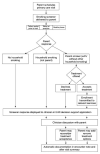Electronic Health Record-Embedded, Behavioral Science-Informed System for Smoking Cessation for the Parents of Pediatric Patients
- PMID: 35584789
- PMCID: PMC9117010
- DOI: 10.1055/s-0042-1748148
Electronic Health Record-Embedded, Behavioral Science-Informed System for Smoking Cessation for the Parents of Pediatric Patients
Abstract
Background: Helping parents quit smoking is a public health priority. However, parents are rarely, if ever, offered tobacco use treatment through pediatric settings. Clinical decision support (CDS) systems developed for the workflows of pediatric primary care may support consistent screening, treatment, and referral.
Objectives: This study aimed to develop a CDS system by using human-centered design (HCD) that identifies parents who smoke, provides motivational messages to quit smoking (informed by behavioral science), and supports delivery of evidence-based tobacco treatment.
Methods: Our multidisciplinary team applied a rigorous HCD process involving analysis of the work environment, user involvement in formative design, iterative improvements, and evaluation of the system's use in context with the following three cohorts: (1) parents who smoke, (2) pediatric clinicians, and (3) clinic staff. Participants from each cohort were presented with scenario-based, high-fidelity mockups of system components and then provided input related to their role in using the CDS system.
Results: We engaged 70 representative participants including 30 parents, 30 clinicians, and 10 clinic staff. A key theme of the design review sessions across all cohorts was the need to automate functions of the system. Parents emphasized a system that presented information in a simple way, highlighted benefits of quitting smoking, and allowed direct connection to treatment. Pediatric clinicians emphasized automating tobacco treatment. Clinical staff emphasized screening for parent smoking via several modalities prior to the patient's visit. Once the system was developed, most parents (80%) reported that it was easy to use, and the majority of pediatricians reported that they would use the system (97%) and were satisfied with it (97%).
Conclusion: A CDS system to support parental tobacco cessation in pediatric primary care, developed through an HCD process, proved easy to use and acceptable to parents, clinicians, and office staff. This preliminary work justifies evaluating the impact of the system on helping parents quit smoking.
Thieme. All rights reserved.
Conflict of interest statement
None declared.
Figures




Similar articles
-
Clinical Decision Support Tool for Parental Tobacco Treatment in Primary Care.Pediatrics. 2016 May;137(5):e20154185. doi: 10.1542/peds.2015-4185. Epub 2016 Apr 14. Pediatrics. 2016. PMID: 27244817
-
Enhancing the electronic health record to increase counseling and quit-line referral for parents who smoke.Acad Pediatr. 2014 Sep-Oct;14(5):478-84. doi: 10.1016/j.acap.2014.03.017. Acad Pediatr. 2014. PMID: 25169159
-
Clinical Decision Support Tool for Parental Tobacco Treatment in Hospitalized Children.Appl Clin Inform. 2016 May 25;7(2):399-411. doi: 10.4338/aci-2015-12-ra-0169. eCollection 2016. Appl Clin Inform. 2016. PMID: 27437049 Free PMC article.
-
Tobacco Control and Treatment for the Pediatric Clinician: Practice, Policy, and Research Updates.Acad Pediatr. 2017 Apr;17(3):233-242. doi: 10.1016/j.acap.2016.12.010. Epub 2017 Jan 6. Acad Pediatr. 2017. PMID: 28069410 Review.
-
The role of pediatric primary care providers in parental smoking cessation: assessing and motivating parents to quit.Pediatr Nurs. 2007 Sep-Oct;33(5):434-41. Pediatr Nurs. 2007. PMID: 18041334 Review.
Cited by
-
A Clinical Decision Support System for Motivational Messaging and Tobacco Cessation Treatment for Parents: Pilot Evaluation of Use and Acceptance.Appl Clin Inform. 2023 May;14(3):439-447. doi: 10.1055/a-2062-9627. Epub 2023 Mar 27. Appl Clin Inform. 2023. PMID: 36972687 Free PMC article.
-
Sharing a Hybrid Electronic Health Record + Fast Healthcare Interoperability Resources Clinical Decision Support across Health Systems: Automating Smoking Cessation for Pediatric Caregivers.Appl Clin Inform. 2025 May;16(3):516-525. doi: 10.1055/a-2535-5823. Epub 2025 Feb 11. Appl Clin Inform. 2025. PMID: 39933722
-
Improving Tobacco Cessation Rates Using Inline Clinical Decision Support.Appl Clin Inform. 2022 Oct;13(5):1116-1122. doi: 10.1055/a-1961-9800. Epub 2022 Oct 17. Appl Clin Inform. 2022. PMID: 36252806 Free PMC article.
-
Addressing Tobacco Screening and Treatment Among Racially and Ethnically Minoritized Parents in Pediatric Clinics: Barriers and Facilitators.Nicotine Tob Res. 2025 Apr 22;27(5):822-829. doi: 10.1093/ntr/ntae264. Nicotine Tob Res. 2025. PMID: 39538428
-
Enhancing Referrals to the Supplemental Nutrition Assistance Program through Clinical Integration of a Standards-Based Decision Support System.Appl Clin Inform. 2025 Jan;16(1):167-176. doi: 10.1055/a-2441-5941. Epub 2024 Oct 15. Appl Clin Inform. 2025. PMID: 39406373
References
-
- National Center for Chronic Disease Prevention and Health Promotion (US) Office on Smoking and Health. . Atlanta, GA: Centers for Disease Control and Prevention (US); 2014. The Health Consequences of Smoking—50 Years of Progress: A Report of the Surgeon General. - PubMed
-
- Office on Smoking and Health (US) . Atlanta, GA: Centers for Disease Control and Prevention (US); 2006. Health Consequences of Involuntary Exposure to Tobacco Smoke: A Report of the Surgeon General. - PubMed
-
- den Exter Blokland E AW, Engels R CME, Hale W W, III, Meeus W, Willemsen M C. Lifetime parental smoking history and cessation and early adolescent smoking behavior. Prev Med. 2004;38(03):359–368. - PubMed
-
- Jha P, Ramasundarahettige C, Landsman V. 21st-century hazards of smoking and benefits of cessation in the United States. N Engl J Med. 2013;368(04):341–350. - PubMed
MeSH terms
Substances
Grants and funding
LinkOut - more resources
Full Text Sources
Medical

